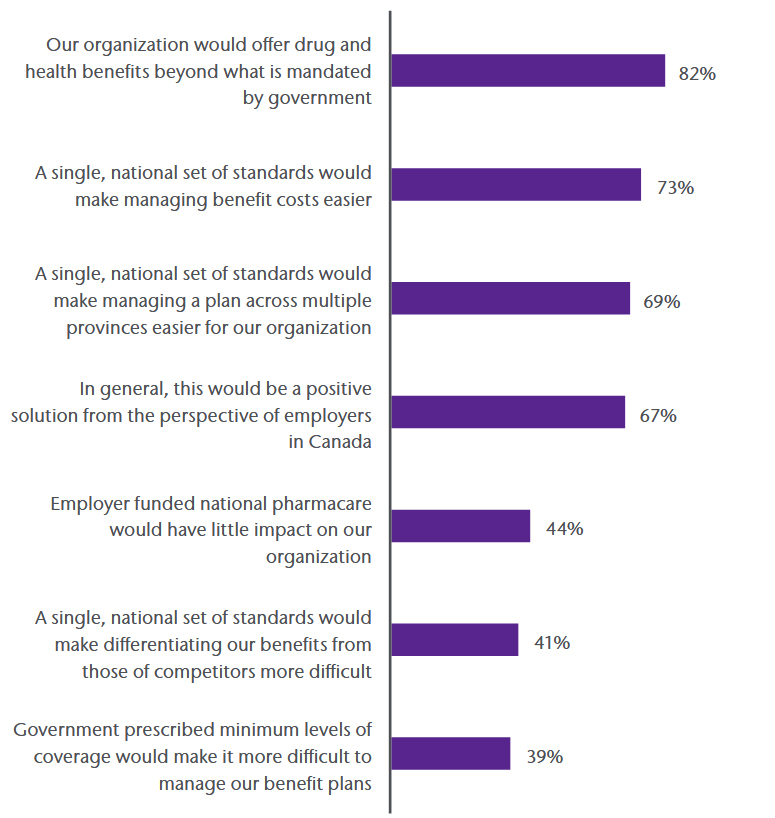Rapid Response: Pharmacare in Canada – The Employer Perspective
This Aon survey asked Canadian human resource leaders for their views on the philosophical underpinnings of a national pharmacare program and the practical aspects of its management. Today, the proportion of prescription drug costs paid by employers through private drug plans is nearly as great as that paid under public drug programs, yet their voice has not been heard in public debate.
The results of this survey show that while Canadian employers agree that coverage of prescription drugs is an important part of the national healthcare system, they have strong viewpoints – and concerns – about the adoption of a national pharmacare program.
The pharmacare gap and employee health
The results of previously published surveys indicate that, in general, most Canadians view the absence of broad-based pharmacare as a gap in an otherwise comprehensive medical system. Employers seem to agree that prescription drug care is fundamental, as is the need for uniform coverage across the country.
| To what degree do employers agree with the philosophical goals behind a national program? |
| Prescription drugs are a fundamental element of the Canadian healthcare system |
92% |
| System cost can be reduced if all provinces negotiate with manufacturers together |
89% |
| Coverage for prescription drugs should not vary by province |
88% |
| Universal drug coverage would improve the health of Canadians |
58% |
| Universal drug coverage would improve the health of employees at my organization |
31% |
It is generally held that a universal pharmacare program would provide the greatest health benefit to low-income Canadians, seniors, and those who are uninsured or underinsured for drugs. Most employers responding to this survey provide employees with some form of private drug coverage; therefore, the expectation is that a national pharmacare program would have a minimal effect on the health of those employees.
Discussion of employee health typically goes beyond traditional drug and extended health programs and overall workforce health remains a strong area of focus. Employer opinion bears this out, as a majority of those surveyed noted that, in the event national pharmacare led to a reduction in benefit costs, savings would be channeled back into other health and wellness programs.
If a national program resulted in savings, how might those savings be reallocated?

Funding options
Respondents expressed an understanding that the implementation of a universal drug program would not come without a cost, and as such, a number of funding scenarios were contemplated. By and large, employers would prefer a dedicated funding approach to one where funding came from general revenues or led to reductions in other program spending.
| Support or strong support for various cost-sharing models |
| Co-payments |
70% |
| Deductibles |
61% |
| Premiums paid annually by all Canadians |
50% |
Figures reflect those indicating support or strong support
Most respondents would not support a system that comes at no cost to the end user. At the same time, there is no real consensus on an optimal funding model.
| Support for potential program funding mechanisms |
Support in some respect |
Do not support |
| Dedicated funding models |
| New pharmacare premium payable by individuals |
72% |
28% |
| Dedicated tax or contribution/premium |
68% |
32% |
| New pharmacare premium payable by employers |
67% |
33% |
| Indirect funding models |
| Increased business and/or payroll taxes |
55% |
45% |
| Increased personal income taxes |
48% |
52% |
| Increased sales taxes |
39% |
61% |
| Decreased funding for other provincial programs such as education and infrastructure |
27% |
73% |
| Decreased funding in other areas of the healthcare system |
25% |
75% |
Administrative models
This survey presented two administrative scenarios:
Model 1: A pharmacare program that is mandated and administered by governments under principles similar to those of the Canada Health Act
In general, employers feel that a government administered program would be a positive solution; however, there appears to be some skepticism that good decisions would be made regarding coverage. Because of this, most still see a need for supplemental employer-paid coverage even if a government-run national pharmacare program existed.
Percentage of employers that agree with statements regarding a scenario in which current medicare programs were expanded to include prescription drugs subject to national standard.

Model 2: A program that is mandated by government, but largely administered by employers under principles similar to the current system in Quebec
Employers also see this as a generally positive approach. Many employers feel that their current coverage is sufficient and that it would meet any national standards. For this reason, a government mandated level of coverage would have little impact on their organization or employees.
Percentage of employers that agree with statements respecting a scenario where employers become the primary providers of drug insurance through a government mandated/employer run program

The road ahead
While employers recognize the need for adequate prescription drug coverage for Canadians, they understand that any national pharmacare program would need to balance cost-effectiveness against adequate coverage. There are a number of different ways to do this – all fraught with challenges. The issue is an important one for Canadian employers. The results of this survey demonstrate a keen interest in how the current pharmacare landscape in Canada might be improved.